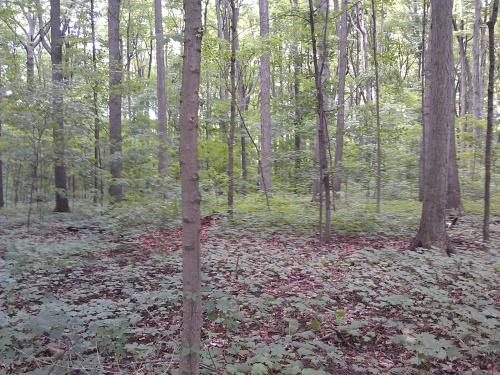Maple-beech forests in your neck of the woods
Live in Southern Michigan? A wealth of diversity awaits in the rich forests of your own “backyard.”
Recently, a small group of high school students had the opportunity to take a quick tour through the 40-acre forest located at Michigan State University’s Tollgate Education Center in Novi, Mich. The tour was a reminder of the incredible diversity of plants and animals that can be found in Michigan’s southern hardwood forests. Tollgate’s forest is a classic example of a beech-maple community. The crowns of the mature trees overhead create a thick, shady green canopy that is typically dominated by sugar maples. In the spring, before the trees have developed full leaf coverage, spring ephemeral wildflowers like trillium, yellow trout lily, spring beauty and wild geranium can blanket the forest floor. Smaller trees and shrubs, like blue beech, juneberry and ironwood, can survive under the thick canopy because they are relatively tolerant of the shade. Since American beech and sugar maple are also highly shade tolerant, these species are able to reproduce and grow in the shade of their parents, therefore perpetuating this mix of dominant tree species.

Photo: A maple-beech “climax” forest is usually dominated by sugar maple seedlings on the forest floor. Photo by G. Peterson, MSU Extension.
Although this type of forest community is considered to be economically and ecologically important in Michigan, this “climax” forest type can tend toward having a less diverse set of tree species if there are no occasional disturbances that open the forest canopy and allow more light to reach the forest floor. By removing small clusters of mature trees in patches at Tollgate’s forest, seedlings of sun-loving species like red oak and black cherry can become established. Since these tree species provide favored food sources for many types of wildlife, these openings can ultimately increase the diversity of the entire forest.
Visitors are welcome to experience this special area for themselves. Tollgate’s forest has trails that are open to the public from dawn to dusk, Monday through Saturday all year.
Michigan State University Extension features other several high quality examples of these beech-maple forests, including both the Sanford and Baker Woodlots on Michigan State University’s campus. For a description of this type of forest community and many others found in the state, the reference book titled Michigan Forest Communities: A Field Guide and Reference (Extension Bulletin E-3000) by Don Dickmann, Department of Forestry Professor Emeritus, can be purchased through the MSU Bookstore.



 Print
Print Email
Email


